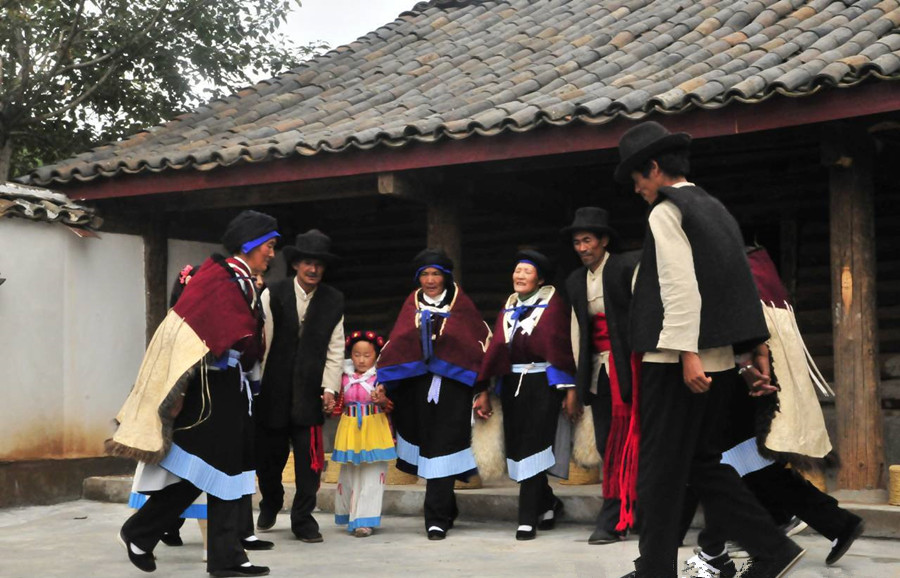
Remeicuo Song and Dance of Dadong Naxi Ethnic Minority in Lijiang
Hot Me Cuo is an ancient collective dance and song form of the Naxi people, passed down in Da Dong Township (大东乡) in the northeastern part of Gucheng District (古城区), Lijiang City (丽江市), Yunnan Province, as well as in the mountainous and river valley areas east of Yulong Snow Mountain (玉龙雪山) and west of the Jinsha River (金沙江). With a history of thousands of years, this form of song and dance is an important part of the traditional folk art of the Naxi people.
Performance Form
-
Number of Performers: Hot Me Cuo performances have no limit on the number of participants, ranging from a dozen to several hundred people.
-
Performance Style: Participants hold hands and form a circle around a bonfire, singing and dancing in a clockwise direction. Men chant “wo re re” while women respond with a trembling voice singing “ai he he.”
-
Dance Movements: The dance movements are simple, natural, bold, and unrestrained, imitating the front legs bending and stretching downward during a sheep fight, with hands pulling each other or holding shoulders.
-
Musical Characteristics: The music is a natural sound from the chest and throat, without instrumental accompaniment or rules of scales and melodies. Men’s parts are led by the “Zuo Luo Ba” (male lead singer), and women’s parts by the “Re Le Mei” (female lead singer). The polyphonic parts are balanced between strength and softness, forming a primitive and beautiful dissonant harmony.
Cultural Connotations
-
Primitive Beliefs: Hot Me Cuo retains the traditional folk art characteristics of the Naxi people, reflecting their reverence for nature and belief in unity for survival.
-
Social Functions: This form of song and dance is not only for entertainment but also plays an important role in funeral and other ceremonies, believed to dispel evil spirits and guide the souls of the deceased back to their ancestors’ home.
-
Cultural Heritage: Hot Me Cuo is passed down through oral teaching and personal experience. Learners need to be exposed to it from a young age and practice for a long time to master the skills.
Heritage and Protection
In 2008, the Naxi Hot Me Cuo was included in the second batch of national intangible cultural heritage list. Da Dong Township, as the best-preserved area of Hot Me Cuo, is known as the “Home of Hot Me Cuo” and has set up several heritage and transmission sites. Local governments and cultural institutions are also actively promoting the inheritance of Hot Me Cuo, including offering related courses in schools.
Modern Development
Today, Hot Me Cuo remains active in Naxi communities and has become an important part of local tourism, attracting many visitors to experience it. This ancient form of song and dance has taken on new vitality in modern society and has become an important symbol of Naxi culture.
Hot Me Cuo, as a unique cultural treasure of the Naxi people, not only showcases the artistic talent of the Naxi people but also carries a profound historical and cultural connotation. Known as a “living musical fossil,” it holds significant value for the study of primitive music and dance.



 7 Days GolfingTour
7 Days GolfingTour
 8 Days Group Tour
8 Days Group Tour
 8 Days Yunnan Tour
8 Days Yunnan Tour
 7 Days Shangri La Hiking
7 Days Shangri La Hiking
 11 Days Yunnan Tour
11 Days Yunnan Tour
 6 Days Yuanyang Terraces
6 Days Yuanyang Terraces
 11 Days Yunnan Tour
11 Days Yunnan Tour
 8 Days South Yunnan
8 Days South Yunnan
 7 Days Tea Tour
7 Days Tea Tour
 8 Days Muslim Tour
8 Days Muslim Tour
 12 Days Self-Driving
12 Days Self-Driving
 4 Days Haba Climbing
4 Days Haba Climbing
 Tiger Leaping Gorge
Tiger Leaping Gorge
 Stone Forest
Stone Forest
 Yunnan-Tibet
Yunnan-Tibet
 Hani Rice Terraces
Hani Rice Terraces
 Kunming
Kunming
 Lijiang
Lijiang
 Shangri-la
Shangri-la
 Dali
Dali
 XishuangBanna
XishuangBanna
 Honghe
Honghe
 Kunming
Kunming
 Lijiang
Lijiang
 Shangri-la
Shangri-la
 Yuanyang Rice Terraces
Yuanyang Rice Terraces
 Nujiang
Nujiang
 XishuangBanna
XishuangBanna
 Spring City Golf
Spring City Golf
 Snow Mountain Golf
Snow Mountain Golf
 Stone Mountain Golf
Stone Mountain Golf



